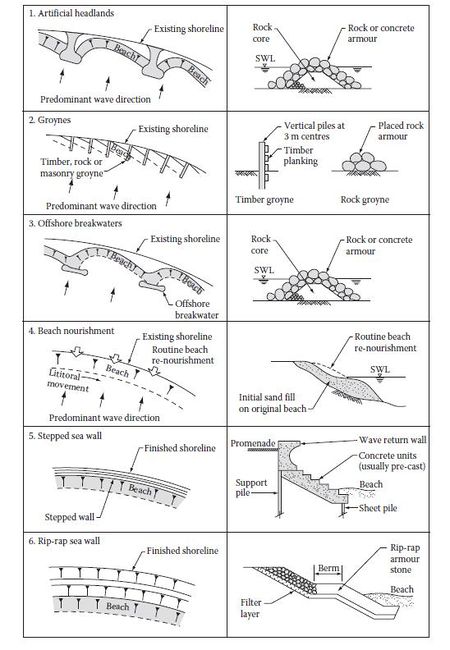The Definitive Guide to Shore Protect Team
Table of ContentsAll about Shore Protect TeamWhat Does Shore Protect Team Mean?Shore Protect Team for DummiesShore Protect Team Fundamentals ExplainedShore Protect Team Things To Know Before You Get ThisExamine This Report about Shore Protect TeamSome Of Shore Protect Team
Reduction in building worth: As the area tourist is affected by disintegration, so after that is the economic situation. Purchasers are much less most likely to look for a coastline house that might be damaged at any type of moment by the impending flooding and erosion emergency. Consequently, residential or commercial property value can drop exceptionally and influence the entire region.Whether a beach is simply small and crowded or has to close completely for the safety of the ecological community and nearby properties, this substantially influences tourist. In turn, neighborhood economic climates are influenced (https://list.ly/shrprtcttm/lists). Risk of injury: The raised threat of flooding and structural failings creates an enhanced risk of injury to nearby tourists and area participants

Shoreline stabilization is straight relevant to their work. Beachfront resorts: Due to the fact that shoreline disintegration effects tourism, it impacts the success of beachfront hotels.
Shore Protect Team for Beginners
This eventually leads to closures and abandoned beachfront residential or commercial properties. Coastal commercial businesses: No visitors indicates no company. For those businesses satisfying citizens, their home goes to danger of damages from erosion and flooding. Coastal state parks: State parks that exist along coasts are at threat of damage. Not only to the manmade frameworks and residential or commercial properties on website, however likewise to the natural ecological communities that exist within.
Hard stablizing uses synthetic frameworks as defense to manage disintegration. The majority of kinds of difficult stabilization like seawalls and sheet metal are not optimal for shoreline stabilization.
The 2-Minute Rule for Shore Protect Team
There's additionally insufficient evidence of their effectiveness relying on the type of shoreline and regional conditions. Tough stabilization techniques tend to be harder to mount and don't match the natural visual, standing out like a sore thumb and harming neighborhood ecosystems in several situations. Beach nutrients is the process of including shed sand and debris back to coastlines after erosion has actually taken place.
TrapBags aid in the process of coastline nutrients by protecting natural environments and allowing plants to expand. While this procedure can be pricey and is not permanent, the pros often tend to exceed the disadvantages. TrapBag obstacles offer lots of properties that make them excellent for seaside and shore disintegration protection. They're: Eco friendly: You can make use of indigenous soil both to border and to fill the TrapBags.

A Biased View of Shore Protect Team
Easy to install: Ease of installation suggests TrapBags can be deployed quickly in case of an emergency situation. They can likewise be mounted with no hefty equipment. Budget friendly: TrapBags are suitable for both small and huge areas of coastline. They supply an inexpensive option to cover projects of any kind of size.
The proper seawall layout depends on location-specific facets, including bordering disintegration processes. There are three major kinds of seawalls: vertical, bent, stepped, and mounds (see table listed below). A record released by the United Nations Environment Programme (UNEP) suggests that the tsunami of 26 December 2004 created much less damages in the locations where natural barriers existed, such as mangroves, coral reefs or seaside plant life.
Natural obstacles, such as coral reefs and mangrove forests, protect against the spread of tsunamis and the circulation of seaside waters and alleviated the flood and surge of water. A cost-benefit approach is an effective means to figure out whether a seawall is suitable and whether the benefits deserve the expense.
Facts About Shore Protect Team Uncovered
A seawall is a static function which can contravene the dynamic nature of the shore and restrain the exchange of sediment in between land and sea. The table listed below sums up some favorable and negative effects of seawalls which can be utilized when contrasting their performance with other coastal monitoring alternatives, such as beach nutrients. [] Advantages and drawbacks of seawalls according to Short (1999) Benefits Drawbacks Long term solution in contrast to soft beach nourishment.

This can cause beaches to dissipate, rendering them worthless for coastline goers. Normally, seawalls can be a successful means to control seaside erosion, yet just if they are built well and out of products that can endure the force of ongoing wave energy.
The Best Strategy To Use For Shore Protect Team
The ideal seawall style counts on location-specific facets, consisting of surrounding disintegration processes. There are 3 primary kinds of seawalls: upright, rounded, tipped, and piles (see table listed below). A report released by the United Nations Environment Program (UNEP) recommends that the tidal wave of 26 December 2004 created much less damage in the areas where natural obstacles existed, such as mangroves, reef or coastal plant life.
All-natural obstacles, such as coral reefs and mangrove woodlands, protect against the spread of tsunamis and the circulation of seaside waters and alleviated the flooding and rise of water. A cost-benefit approach is a reliable way to determine whether a seawall is suitable and whether the benefits deserve the expense.
The Greatest Guide To Shore Protect Team
A seawall is a static feature which can contrast with the vibrant nature of the shore and hamper the exchange of debris between land and sea. Advantages and disadvantages of seawalls according to Short (1999) Benefits Downsides Long term service in contrast to soft coastline nutrition.

This can create beaches to dissipate, rendering them pointless for beach goers. Usually, seawalls can be an effective means to regulate coastal disintegration, yet only if they are built well and out of products that can hold up against the force of continuous wave power. Some understanding is required of the seaside procedures and morphodynamics specific to the seawall place.